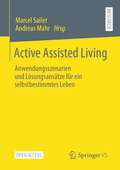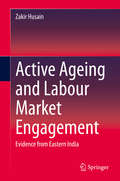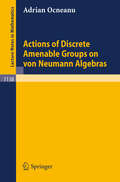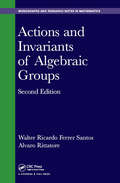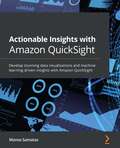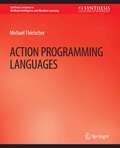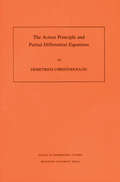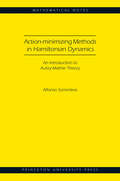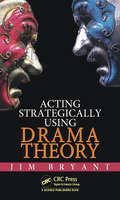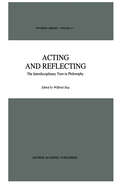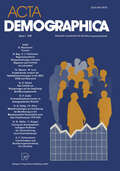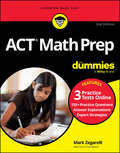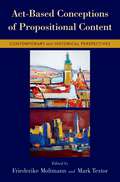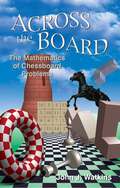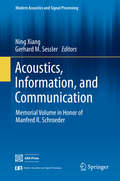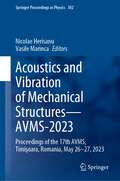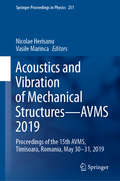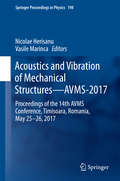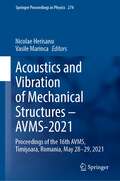- Table View
- List View
Active Assisted Living: Anwendungsszenarien und Lösungsansätze für ein selbstbestimmtes Leben
by Marcel Sailer Andreas MahrIn dem vorliegenden Open-Access-Buch identifizieren Studierende und Lehrende interprofessionell Entwicklungen und Problemfelder der Assistiven Technologien. Diese halten zunehmend Einzug ins Leben versorgungsbedürftiger, häufig älterer Menschen. Nach einigen Jahren der Entwicklung kann konstatiert werden, dass der Transfer von Entwicklung zur Anwendung im Alltag infolge unterschiedlicher Perspektiven und Zielsetzungen nur unzureichend stattfindet. Die Beitragsautoren bieten kreative Lösungsansätze, die zu einer nachhaltigen Umsetzung führen sollen.Dies ist ein Open-Access-Buch.
Active Ageing and Labour Market Engagement: Evidence from Eastern India
by Zakir HusainThe book provides an interesting analysis of the time-use data to examine the extent to which active ageing is occurring in India. It also synthesizes data from the National Sample Survey Office All India Survey and another survey undertaken in Kolkata, Bhubaneswar, and Ranchi (capital cities of East Indian states) to examine the role of the aged in the Indian Society. Nearly all countries in the world are experiencing an important issue of ageing. India faces its own set of challenges with its aging population due to the absence of a social security system—the shifting family dynamics questions the contribution of the elderly to the family in every aspect. Econometric models have been used in the book to study gender differences and variations across socio-economic conditions, correlating them to the contribution of the aged to their families and the extent of active ageing. The book broadens the understanding on the aged and facilitates their integration in the society so that they can age more actively. Active Ageing and Labour Market Engagement offers an analytical perspective to professionals, researchers, and policy makers interested in gerontology.
Actions of Discrete Amenable Groups on von Neumann Algebras (Lecture Notes in Mathematics #1138)
by Adrian OcneanuActions and Invariants of Algebraic Groups (Chapman & Hall/CRC Monographs and Research Notes in Mathematics)
by Walter Ricardo Ferrer Santos Alvaro RittatoreActions and Invariants of Algebraic Groups, Second Edition presents a self-contained introduction to geometric invariant theory starting from the basic theory of affine algebraic groups and proceeding towards more sophisticated dimensions." Building on the first edition, this book provides an introduction to the theory by equipping the reader with the tools needed to read advanced research in the field. Beginning with commutative algebra, algebraic geometry and the theory of Lie algebras, the book develops the necessary background of affine algebraic groups over an algebraically closed field, and then moves toward the algebraic and geometric aspects of modern invariant theory and quotients.
Actions and Invariants of Algebraic Groups (Chapman & Hall/CRC Monographs and Research Notes in Mathematics)
by Walter Ricardo Ferrer Santos Alvaro RittatoreActions and Invariants of Algebraic Groups, Second Edition presents a self-contained introduction to geometric invariant theory starting from the basic theory of affine algebraic groups and proceeding towards more sophisticated dimensions." Building on the first edition, this book provides an introduction to the theory by equipping the reader with the tools needed to read advanced research in the field. Beginning with commutative algebra, algebraic geometry and the theory of Lie algebras, the book develops the necessary background of affine algebraic groups over an algebraically closed field, and then moves toward the algebraic and geometric aspects of modern invariant theory and quotients.
Actionable Science of Global Environment Change: From Big Data to Practical Research
by Ziheng SunThis volume teaches readers how to sort through the vast mountain of climate and environmental science data to extract actionable insights. With the advancements in sensing technology, we now observe petabytes of data related to climate and the environment. While the volume of data is impressive, collecting big data for the sake of data alone proves to be of limited utility. Instead, our quest is for actionable data that can drive tangible actions and meaningful impact.Yet, unearthing actionable insights from the accumulated big data and delivering them to global stakeholders remains a burgeoning field. Although traditional data mining struggles to keep pace with data accumulation, scientific evolution has spurred the emergence of new technologies like numeric modeling and machine learning. These cutting-edge tools are now tackling grand challenges in climate and the environment, from forecasting extreme climate events and enhancing environmental productivity to monitoring greenhouse gas emissions, fostering smart environmental solutions, and understanding aerosols. Additionally, they model environmental-human interactions, inform policy, and steer markets towards a healthier and more environment-friendly direction.While there's no universal solution to address all these formidable tasks, this book takes us on a guided journey through three sections, enriched with chapters from domain scientists. Part I defines actionable science and explores what truly renders data actionable. Part II showcases compelling case studies and practical use scenarios, illustrating these principles in action. Finally, Part III provides an insightful glimpse into the future of actionable science, focusing on the pressing climate and environmental issues we must confront.Embark on this illuminating voyage with us, where big data meets practical research, and discover how our collective efforts move us closer to a sustainable and thriving future. This book is an invitation to unlock the mysteries of our environment, transforming data into decisive action for generations to come.
Actionable Insights With Amazon Quicksight: Develop Stunning Data Visualizations And Machine Learning-driven Insights With Amazon Quicksight (pdf)
by Manos SamatasDevelop stunning data visualizations and machine learning-driven insights with Amazon QuickSight
Action Programming Languages (Synthesis Lectures on Artificial Intelligence and Machine Learning)
by Michael HexmoorArtificial systems that think and behave intelligently are one of the most exciting and challenging goals of Artificial Intelligence. Action Programming is the art and science of devising high-level control strategies for autonomous systems which employ a mental model of their environment and which reason about their actions as a means to achieve their goals. Applications of this programming paradigm include autonomous software agents, mobile robots with high-level reasoning capabilities, and General Game Playing. These lecture notes give an in-depth introduction to the current state-of-the-art in action programming. The main topics are knowledge representation for actions, procedural action programming, planning, agent logic programs, and reactive, behavior-based agents. The only prerequisite for understanding the material in these lecture notes is some general programming experience and basic knowledge of classical first-order logic. Table of Contents: Introduction / Mathematical Preliminaries / Procedural Action Programs / Action Programs and Planning / Declarative Action Programs / Reactive Action Programs / Suggested Further Reading
The Action Principle and Partial Differential Equations. (AM-146), Volume 146
by Demetrios ChristodoulouThis book introduces new methods in the theory of partial differential equations derivable from a Lagrangian. These methods constitute, in part, an extension to partial differential equations of the methods of symplectic geometry and Hamilton-Jacobi theory for Lagrangian systems of ordinary differential equations. A distinguishing characteristic of this approach is that one considers, at once, entire families of solutions of the Euler-Lagrange equations, rather than restricting attention to single solutions at a time. The second part of the book develops a general theory of integral identities, the theory of "compatible currents," which extends the work of E. Noether. Finally, the third part introduces a new general definition of hyperbolicity, based on a quadratic form associated with the Lagrangian, which overcomes the obstacles arising from singularities of the characteristic variety that were encountered in previous approaches. On the basis of the new definition, the domain-of-dependence theorem and stability properties of solutions are derived. Applications to continuum mechanics are discussed throughout the book. The last chapter is devoted to the electrodynamics of nonlinear continuous media.
Action-minimizing Methods in Hamiltonian Dynamics (MN-50): An Introduction to Aubry-Mather Theory
by Alfonso SorrentinoJohn Mather's seminal works in Hamiltonian dynamics represent some of the most important contributions to our understanding of the complex balance between stable and unstable motions in classical mechanics. His novel approach—known as Aubry-Mather theory—singles out the existence of special orbits and invariant measures of the system, which possess a very rich dynamical and geometric structure. In particular, the associated invariant sets play a leading role in determining the global dynamics of the system. This book provides a comprehensive introduction to Mather’s theory, and can serve as an interdisciplinary bridge for researchers and students from different fields seeking to acquaint themselves with the topic.Starting with the mathematical background from which Mather’s theory was born, Alfonso Sorrentino first focuses on the core questions the theory aims to answer—notably the destiny of broken invariant KAM tori and the onset of chaos—and describes how it can be viewed as a natural counterpart of KAM theory. He achieves this by guiding readers through a detailed illustrative example, which also provides the basis for introducing the main ideas and concepts of the general theory. Sorrentino then describes the whole theory and its subsequent developments and applications in their full generality.Shedding new light on John Mather’s revolutionary ideas, this book is certain to become a foundational text in the modern study of Hamiltonian systems.
Action-minimizing Methods in Hamiltonian Dynamics (MN-50): An Introduction to Aubry-Mather Theory (PDF)
by Alfonso SorrentinoJohn Mather's seminal works in Hamiltonian dynamics represent some of the most important contributions to our understanding of the complex balance between stable and unstable motions in classical mechanics. His novel approach—known as Aubry-Mather theory—singles out the existence of special orbits and invariant measures of the system, which possess a very rich dynamical and geometric structure. In particular, the associated invariant sets play a leading role in determining the global dynamics of the system. This book provides a comprehensive introduction to Mather’s theory, and can serve as an interdisciplinary bridge for researchers and students from different fields seeking to acquaint themselves with the topic.Starting with the mathematical background from which Mather’s theory was born, Alfonso Sorrentino first focuses on the core questions the theory aims to answer—notably the destiny of broken invariant KAM tori and the onset of chaos—and describes how it can be viewed as a natural counterpart of KAM theory. He achieves this by guiding readers through a detailed illustrative example, which also provides the basis for introducing the main ideas and concepts of the general theory. Sorrentino then describes the whole theory and its subsequent developments and applications in their full generality.Shedding new light on John Mather’s revolutionary ideas, this book is certain to become a foundational text in the modern study of Hamiltonian systems.
Acting Strategically Using Drama Theory
by James William BryantIn today's confrontational and connected world, communication is the key strategic act. This book uses drama theory-a radical extension of game theory-to show how best to communicate so as to manage the emotionally charged confrontations occurring in any worthwhile relationship. Alongside a toolset that provides a systematic framework for analysing
Acting and Reflecting: The Interdisciplinary Turn in Philosophy (Synthese Library #211)
by Wilfried SiegActa Demographica: Deutsche Gesellschaft für Bevölkerungswissenschaft e.V.
by Günter Buttler Hans-Joachim Hoffmann-Nowotny Gerhard Schmitt-RinkACT Math Prep For Dummies: Book + 3 Practice Tests Online
by Mark ZegarelliImprove your score on the math section of the ACT A good math score on the ACT exam can set you on the path to a number of rewarding college programs and future careers, especially in the STEM fields. ACT Math Prep For Dummies walks you through this challenging exam section, with simple explanations of math concepts and proven test-taking strategies. Now including access to an all-new online test bank—so you can hammer out even more practice sessions—this book will help you hone your skills in pre-algebra, algebra, geometry, trigonometry and beyond. Handy problem-solving tips mean you’ll be prepared for the ever-more-advanced questions that the ACT throws at students each year. Learn exactly what you’ll need to know to score well on the ACT math section Get tips for solving problems quicker and making good guesses when you need to Drill down into more complex concepts like matrices and functions Practice, practice, practice, with three online testsIf you’re a high school student preparing to take the ACT and you need extra math practice, ACT Math Prep For Dummies has your back.
ACT Math Prep For Dummies: Book + 3 Practice Tests Online
by Mark ZegarelliImprove your score on the math section of the ACT A good math score on the ACT exam can set you on the path to a number of rewarding college programs and future careers, especially in the STEM fields. ACT Math Prep For Dummies walks you through this challenging exam section, with simple explanations of math concepts and proven test-taking strategies. Now including access to an all-new online test bank—so you can hammer out even more practice sessions—this book will help you hone your skills in pre-algebra, algebra, geometry, trigonometry and beyond. Handy problem-solving tips mean you’ll be prepared for the ever-more-advanced questions that the ACT throws at students each year. Learn exactly what you’ll need to know to score well on the ACT math section Get tips for solving problems quicker and making good guesses when you need to Drill down into more complex concepts like matrices and functions Practice, practice, practice, with three online testsIf you’re a high school student preparing to take the ACT and you need extra math practice, ACT Math Prep For Dummies has your back.
Act-Based Conceptions of Propositional Content: Contemporary and Historical Perspectives
by Friederike Moltmann and Mark TextorThe notion of a propositional content plays a central role in contemporary philosophy of language. Propositional content makes up both the meaning of sentences and the content of propositional attitudes such as belief. One particular view about propositional content has been dominant in analytic philosophy, namely the Fregean conception of propositions as abstract mind-independent objects that come with truth conditions. But propositions in this sense raise a range of issues, which have become a center of debate in current philosophy of language. In particular, how should propositions as abstract objects be understood and how can they represent things and be true or false? A number of philosophers in contemporary analytic philosophy as well as in early analytic philosophy and phenomenology have approached the notion of a propositional content in a different way, not by starting out with an abstract truth berarer, but by focusing on cognitive acts of agents, such as acts of judging. It is in terms of such acts that the notion of a propositional content, on their view, should be understood. The act-based perspective historically goes back to the work of Central European philosophers, in particular that of Husserl, Twardowski, Meinong, and Reinach. However, their work has been unduly neglected and is in fact largely inaccessible to contemporary analytic philosophers. The volume presents a central selection of work of these philosophers that bear on an act-based conception of philosophical content, some of which in new translations (one paper by Reinach), some of which published in English for the very first time (two papers by Twardowski). In addition, the volume presents new work by leading contemporary philosophers of language pursuing or discussing an act-based conception of propositional content. Moreover, the book contains a crosslinguistic study of nominalizations for actions and products, a distinction that plays a central role in the philosophy of language of Twardowski.
Act-Based Conceptions of Propositional Content: Contemporary and Historical Perspectives
The notion of a propositional content plays a central role in contemporary philosophy of language. Propositional content makes up both the meaning of sentences and the content of propositional attitudes such as belief. One particular view about propositional content has been dominant in analytic philosophy, namely the Fregean conception of propositions as abstract mind-independent objects that come with truth conditions. But propositions in this sense raise a range of issues, which have become a center of debate in current philosophy of language. In particular, how should propositions as abstract objects be understood and how can they represent things and be true or false? A number of philosophers in contemporary analytic philosophy as well as in early analytic philosophy and phenomenology have approached the notion of a propositional content in a different way, not by starting out with an abstract truth berarer, but by focusing on cognitive acts of agents, such as acts of judging. It is in terms of such acts that the notion of a propositional content, on their view, should be understood. The act-based perspective historically goes back to the work of Central European philosophers, in particular that of Husserl, Twardowski, Meinong, and Reinach. However, their work has been unduly neglected and is in fact largely inaccessible to contemporary analytic philosophers. The volume presents a central selection of work of these philosophers that bear on an act-based conception of philosophical content, some of which in new translations (one paper by Reinach), some of which published in English for the very first time (two papers by Twardowski). In addition, the volume presents new work by leading contemporary philosophers of language pursuing or discussing an act-based conception of propositional content. Moreover, the book contains a crosslinguistic study of nominalizations for actions and products, a distinction that plays a central role in the philosophy of language of Twardowski.
Across the Board: The Mathematics of Chessboard Problems
by John J. WatkinsAcross the Board is the definitive work on chessboard problems. It is not simply about chess but the chessboard itself--that simple grid of squares so common to games around the world. And, more importantly, the fascinating mathematics behind it. From the Knight's Tour Problem and Queens Domination to their many variations, John Watkins surveys all the well-known problems in this surprisingly fertile area of recreational mathematics. Can a knight follow a path that covers every square once, ending on the starting square? How many queens are needed so that every square is targeted or occupied by one of the queens? Each main topic is treated in depth from its historical conception through to its status today. Many beautiful solutions have emerged for basic chessboard problems since mathematicians first began working on them in earnest over three centuries ago, but such problems, including those involving polyominoes, have now been extended to three-dimensional chessboards and even chessboards on unusual surfaces such as toruses (the equivalent of playing chess on a doughnut) and cylinders. Using the highly visual language of graph theory, Watkins gently guides the reader to the forefront of current research in mathematics. By solving some of the many exercises sprinkled throughout, the reader can share fully in the excitement of discovery. Showing that chess puzzles are the starting point for important mathematical ideas that have resonated for centuries, Across the Board will captivate students and instructors, mathematicians, chess enthusiasts, and puzzle devotees.
Across the Board: The Mathematics of Chessboard Problems (PDF)
by John J. WatkinsAcross the Board is the definitive work on chessboard problems. It is not simply about chess but the chessboard itself--that simple grid of squares so common to games around the world. And, more importantly, the fascinating mathematics behind it. From the Knight's Tour Problem and Queens Domination to their many variations, John Watkins surveys all the well-known problems in this surprisingly fertile area of recreational mathematics. Can a knight follow a path that covers every square once, ending on the starting square? How many queens are needed so that every square is targeted or occupied by one of the queens? Each main topic is treated in depth from its historical conception through to its status today. Many beautiful solutions have emerged for basic chessboard problems since mathematicians first began working on them in earnest over three centuries ago, but such problems, including those involving polyominoes, have now been extended to three-dimensional chessboards and even chessboards on unusual surfaces such as toruses (the equivalent of playing chess on a doughnut) and cylinders. Using the highly visual language of graph theory, Watkins gently guides the reader to the forefront of current research in mathematics. By solving some of the many exercises sprinkled throughout, the reader can share fully in the excitement of discovery. Showing that chess puzzles are the starting point for important mathematical ideas that have resonated for centuries, Across the Board will captivate students and instructors, mathematicians, chess enthusiasts, and puzzle devotees.
Acoustics, Information, and Communication: Memorial Volume in Honor of Manfred R. Schroeder (Modern Acoustics and Signal Processing)
by Ning Xiang Gerhard M. SesslerThis book explores the life and scientific legacy of Manfred Schroeder through personal reflections, scientific essays and Schroeder’s own memoirs. Reflecting the wide range of Schroeder’s activities, the first part of the book contains thirteen articles written by his colleagues and former students. Topics discussed include his early, pioneering contributions to the understanding of statistical room acoustics and to the measurement of reverberation time; his introduction of digital signal processing methods into acoustics; his use of ray tracing methods to study sound decay in rooms and his achievements in echo and feedback suppression and in noise reduction. Other chapters cover his seminal research in speech processing including the use of predictive coding to reduce audio bandwidth which led to various code-excited linear prediction schemes, today used extensively for speech coding. Several chapters discuss Schroeder’s work in low-peak factor signals, number theory, and maximum-length sequences with key applications in hearing research, diffraction gratings, artificial reverberators and de-correlation techniques for enhancing subjective envelopment in surround sound. In style, the articles range from truly scientific to conversationally personal. In all contributions, the relationship between the current research presented and Manfred Schroeder’s own fields of interest is, in general, evident. The second part of the book consists of Schroeder’s own memoirs, written over the final decade of his life. These recollections shed light on many aspects not only of Schroeder’s life but also on that of many of his colleagues, friends and contemporaries. They portray political, social and scientific events over a period that extends from pre-war to the present. These memoirs, written in an inimitable and witty style, are full of information, entertaining and fun to read, providing key insight into the life and work of one of the greatest acousticians of the 20th century.
Acoustics and Vibration of Mechanical Structures—AVMS-2023: Proceedings of the 17th AVMS, Timişoara, Romania, May 26–27, 2023 (Springer Proceedings in Physics #302)
by Nicolae Herisanu Vasile MarincaThis book presents peer-reviewed and selected papers from the 17th Conference on Acoustics and Vibration of Mechanical Structures (AVMS) held in Timisoara, Romania, on 26–27 May 2023. Internationally recognized experts share their knowledge and key findings in a broad range of topics related to acoustics and vibration of mechanical structures such as analytical, numerical and experimental techniques for noise and vibration problems, environmental and occupational noise and vibration, modelling, prediction and simulations of noise and vibration, noise and vibration control, noise and vibration attenuators. The book addresses application studies and fundamental studies as well, and it is meant for academics researchers and professionals, as well as Ph.D. students concerned with various fields of acoustics and vibration of mechanical structures.
Acoustics and Vibration of Mechanical Structures—AVMS 2019: Proceedings of the 15th AVMS, Timisoara, Romania, May 30–31, 2019 (Springer Proceedings in Physics #251)
by Nicolae Herisanu Vasile MarincaThis book contains selected and expanded contributions presented at the 15th Conference on Acoustics and Vibration of Mechanical Structures held in Timisoara, Romania, May 30-31, 2019. The conference focused on a broad range of topics related to acoustics and vibration, such as analytical approaches to nonlinear noise and vibration problems, environmental and occupational noise, structural vibration, biomechanics and bioacoustics, as well as experimental approaches to vibration problems in industrial processes. The different contributions also address the analytical, numerical and experimental techniques applicable to analyze linear and non-linear noise and vibration problems (including strong nonlinearity) and they are primarily intended to emphasize the actual trends and state-of-the-art developments in the above mentioned topics. The book is meant for academics, researchers and professionals, as well as PhD students concerned with various fields of acoustics and vibration of mechanical structures.
Acoustics and Vibration of Mechanical Structures—AVMS-2017: Proceedings of the 14th AVMS Conference, Timisoara, Romania, May 25–26, 2017 (Springer Proceedings in Physics #198)
by Nicolae Herisanu Vasile MarincaThis book is a collection of papers presented at Acoustics and Vibration of Mechanical Structures 2017 – AVMS 2017 – highlighting the current trends and state-of-the-art developments in the field. It covers a broad range of topics, such as noise and vibration control, noise and vibration generation and propagation, the effects of noise and vibration, condition monitoring and vibration testing, modeling, prediction and simulation of noise and vibration, environmental and occupational noise and vibration, noise and vibration attenuators, as well as biomechanics and bioacoustics. The book also presents analytical, numerical and experimental techniques for evaluating linear and non-linear noise and vibration problems (including strong nonlinearity). It is primarily intended for academics, researchers and professionals, as well as PhD students in various fields of the acoustics and vibration of mechanical structures.
Acoustics and Vibration of Mechanical Structures – AVMS-2021: Proceedings of the 16th AVMS, Timişoara, Romania, May 28-29, 2021 (Springer Proceedings in Physics #274)
by Nicolae Herisanu Vasile MarincaThis book is a collection of contributions presented at the 16th Conference on Acoustic and Vibration of Mechanical Structure held in Timişoara, Romania, May 28, 2021. The conference focused on a broad range of topics related to acoustics and vibration, such as noise and vibration control, noise and vibration generation and propagation, effects of noise and vibration, condition monitoring and vibration testing, modelling, prediction and simulation of noise and vibration, environmental and occupational noise and vibration, noise and vibration attenuators, biomechanics and bioacoustics. The book also discusses analytical, numerical and experimental techniques applicable to analyze linear and non-linear noise and vibration problems (including strong nonlinearity) and it is primarily intended to emphasize the actual trends and state-of-the-art developments in the above mentioned topics. The primary audience of this book consist of academics, researchers and professionals, as well as PhD students concerned with various fields of acoustics and vibration of mechanical structures.
